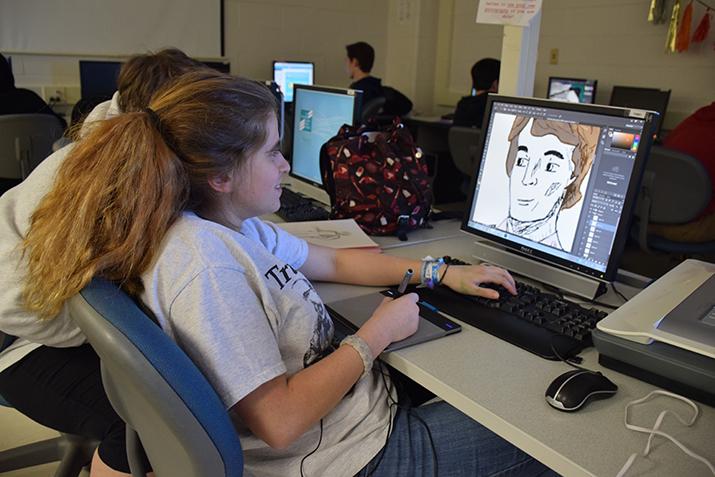
Creativity continues to be a sought-after skill in high school graduates. Post-secondary educators and employers recognize the need for this next generation to be content creators who can design original, eye-catching art and text to represent the brand, company, or institution. Truly, creating is no longer just for the art major; it’s beneficial for all students to have experience in creating digital art as part of their repertoire. When students have digital art in their portfolio, it showcases them as versatile and flexible.
Although some teachers may view digital art as intimidating, it’s important to consider how this art form can break down the barriers for those students who don’t see themselves as artists capable of working with a traditional medium. Digital drawing tools today are intuitive, easy to use, and may be more approachable to digital natives than a medium like canvas and charcoal. Additionally, with so many apps to choose from (check out this list of student-friendly 12 digital art apps), teachers can select apps that meet the appropriate ability and skill level of the class.
Educators seeking to blend digital art into their curriculum should gain some familiarity with digital art tools as a starting point. With a litany of graphic and digital artists now sharing their tips of the trade, take advantage of the various beginners guides such as “Teach Yourself Digital Art” and this “Must Have Starter Kit”.
Most graphic artists offer a spectrum of equipment to choose from, offering something for each budget. Pen tablets are the preferred method for professional digital artists, but many of the web-based software programs work adequately with laptops, Chromebooks, and a classroom set of mice. For those teachers with an ample budget to purchase drawing tablets, this Essential Picks site reviews various options of individual and bundle options.
Collaborating with the district’s art department may also be beneficial in maximizing the budget. Many schools have graphic design labs where teachers could take classes for the day or week while working on a project. With a little schedule coordination, it’s possible to tap into resources that are already available within the school.
Here are some of the other benefits in allowing students to create digital art within any subject area:
- It allows for a novel type of expression.
Digital art serves as an excellent alternative to a traditional assessment that allows students to express their personality and original ideas. The medium is generally novel for students, which inherently boosts engagement.
- It raises awareness of aesthetics and principles of design.
Using models and examples of digital art, teachers can create lessons on design principles such as balance, proportion, and contrast. Visual communication is highly important in our world today, so any opportunity to grow students in this regard is a win.
- Digital art allows students to recap or tell a story in a new way.
Many digital art platforms now offer comic development. Students could retell a chapter from a book with a comic or create a “sketchnote style” poster recapping a difficult concept. While it might take more instruction and time, the benefits in having students create an original piece of art are worth it.
- Students can demonstrate a deep level of understanding by creating digital art.
Composing art requires a great deal of processing, thought, and intention. Rather than simply recalling information like a traditional quiz, these digital art tools allow students to show their understanding and how they made their own meaning.
- Digital art is easily shareable.
Teachers can create community and invite students to see new perspectives by having classes share their digital products with each other. With LMS’s like Google Classroom and Edmodo, students can easily post their work for others to comment and view.
- These projects can expose students to careers like graphic design and animation.
Teachers may choose to use digital art tools in their classroom as a way to expose students to a colossal creative career path. The Inside Pixar series on Disney Plus may serve as a great accompaniment here, as it zooms in on the creative minds behind many students’ favorite movies. Pixar and other animation studios are arguably the pinnacle of any digital artists’ career, but the jobs in the industry are growing rapidly all across the country and world.
- Digital art develops students’ attention to detail, patience, and grit.
Using more advanced digital drawing tools like in the Adobe suite requires robust self-directed learning. Students can learn how to seek out resources on their own from YouTube channels or other educational sites in order to learn and master a new effect. Moreover, many digital art software programs ask students to work in pixels, a unit that requires students to focus on every single detail of their piece. All of this instills those necessary soft skills for students to develop to transfer into new challenges and career endeavors.
- Digital art products serve as artifacts for class reflection and discussion.
Teachers can ask students to create digital art at various points in the school year as a way to capture learning and understanding. The class can then use these as artifacts to reflect on their growth and shifts in understanding. Often, art communicates more viscerally than simply text. Students may find it enjoyable to look back on their work and see how far they’ve come. When digital art is printed and displayed in the classroom, it can also create a sense of pride for many students.
Overall, incorporating digital art into the classroom fosters the creative mind while offering a novel and fun opportunity for students to express themselves. Teachers, too, will find enjoyment in using digital art as a formative or summative assessment, as it puts the mundane grading aside, instead inviting unique products to grade. Whether it be a comic strip, a persuasive poster, an illustration of a new character, or an abstract painting capturing the mood of a time in history, the possibilities are endless for teachers to incorporate this medium into their curriculum.
